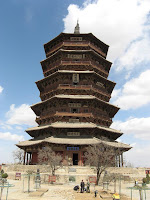It's a fairly large city and so bus transport was a necessity in Chengdu, this was complicated by the construction of a metro system, that results in some one way roads and the solution that buses follow a different route in one direction to the other. This left me hopelessly lost for a while on my first evening trying to get back to the hostel. I noted to get off at the first stop north of the river, but a few moments after alighting I realised this was a different street and completely lost my bearings for a while, confused by the route change of the bus. This was further confused by some friendly local who saw me looking puzzled at a map and tried to help, but he had no idea where I was either and in trying to help, made things worse ;)


Left: Performing Buddhist chants.
Right: Daci Si's tea garden.
I quite liked Chengdu, it has a nice atmosphere, a location convenient for travel to many interesting places around and generally friendly, relaxed people. As well as seeing the giant pandas nearby and visiting Leshan (twice - returned a few days later to extend my visa), I popped into a couple of nearby temples and also to the first 'Irish Bar' I have seen in China, (I never found "The Paddy Field" in Guangzhou) which gave the chance to watch some football and indulge in an excellent dish of sausage and mash. It wasn't all good though as it also meant being surrounded by noisy, drunk Australians for a couple of hours. Another evening I visited another ex-pat favourite bar, 'the bookworm', which I was taken to by TT, a Chengdu local who I met in Dandong some time ago. This place was a bit like a library in that it had bookshelves full of books all around, but was far from quiet as there was a horse race event and auction going on which involved lots more noisy Australians, can't get away from them!
 No noisy Australians at the temples I visited thankfully, Wenshu Yuan was very close to the hostel and worth a quick visit as in one of the halls, monks and non-monks(?) were reading from Buddhist scriptures and performing chants. While the Daci si is a temple dedicated to the travelling monk Xuanzang, who at one time lived in Chengdu before starting his journey to India, from where he brought back Buddhist scriptures that introduced Buddhism into these parts. I have mentioned Xuanzang previously in my blog from a statue in Lanzhou, to artistic impressions in the Big Goose Pagoda in Xi'an where he lived much of his life, he was of course the subject of the books 'Journey to the West', dramatised in Europe as the TV show 'Monkey'.
No noisy Australians at the temples I visited thankfully, Wenshu Yuan was very close to the hostel and worth a quick visit as in one of the halls, monks and non-monks(?) were reading from Buddhist scriptures and performing chants. While the Daci si is a temple dedicated to the travelling monk Xuanzang, who at one time lived in Chengdu before starting his journey to India, from where he brought back Buddhist scriptures that introduced Buddhism into these parts. I have mentioned Xuanzang previously in my blog from a statue in Lanzhou, to artistic impressions in the Big Goose Pagoda in Xi'an where he lived much of his life, he was of course the subject of the books 'Journey to the West', dramatised in Europe as the TV show 'Monkey'.A bit of a treat at this temple was a tea house in the back garden that I decided to try out, surprisingly for such a quiet place, I found it was packed with locals sipping tea and chatting, clearly one of the famous Sichuan tea houses which are a feature of Chengdu and Sichuan province. So I grabbed a table, chose some unknown tea, sat and read in the sunshine for a while as locals chatted away creating a busy atmosphere of relaxation. Nice place if you like to drink tea ;)
Also while in the hostel in Chengdu I learnt how to play some new Chinese card games with some Chinese guests from Kunming, Guangzhou and Xiamen. I wasn't sure what was going on at first and communication was a little tricky due to language barrier but I had some expert help from one of the players and soon became quite successful, beginner's luck of course ! Instead of playing for money, their payment for losing is that you get your face painted by the winner, this was the result.

See, I did quite well ! The guy on the right wasn't playing, hence no warpaint.













































